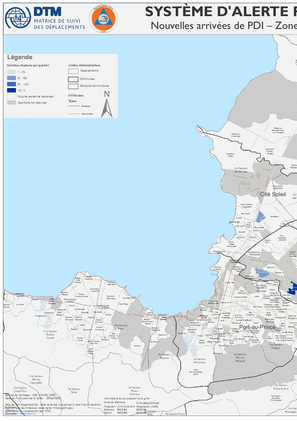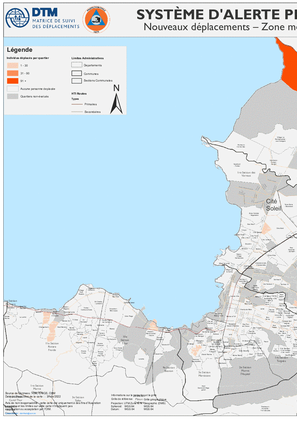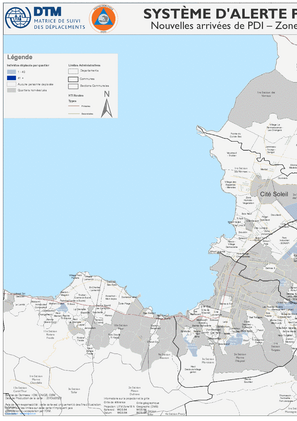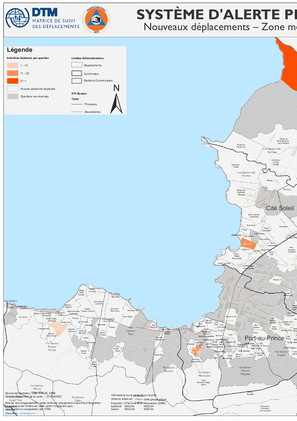-
Countries
-
Data and Analysis
-
Special Focus
-
Crisis Responses
Contact
DTM Burundi, DTMBurundi@iom.int
Location
Burundi
Activity
- Mobility Tracking
- Event Tracking
Period Covered
Oct 31 2022 -Nov 06 2022
Activated on an ad hoc basis, the DTM Emergency Tracking provides early field reports at the beginning of a complex crisis, allowing IOM to gather, consolidate and disseminate baseline information on displacement and return figures at the onset of a newly emerging crisis. The DTM Emergency Tracking relies heavily on information provided by RARTs or partners within the humanitarian community about an unfolding situation. The Emergency Tracking gathers data through IOM Burundi’s extended network of key informants, who provide basic information on the new displacement, be it of IDPs or returnees, or both, including numbers, location and shelter types. While IOM DTM strives to provide best estimates, the Emergency Tracking aims to be a quick monitoring tool with real-time data turnover ranging from 24 to 72 hours following its activation.
Population Groups
Survey Methodology
Unit of Analysis Or Observation
Type of Survey or Assessment
Keywords
Geographical Scope
Administrative boundaries with available data
The current dataset covers the following administrative boundaries
Contact
DTM Burundi, DTMBurundi@iom.int
Location
Burundi
Activity
- Mobility Tracking
- Event Tracking
Period Covered
Oct 24 2022 -Oct 30 2022
Activated on an ad hoc basis, the DTM Emergency Tracking provides early field reports at the beginning of a complex crisis, allowing IOM to gather, consolidate and disseminate baseline information on displacement and return figures at the onset of a newly emerging crisis. The DTM Emergency Tracking relies heavily on information provided by RARTs or partners within the humanitarian community about an unfolding situation. The Emergency Tracking gathers data through IOM Burundi’s extended network of key informants, who provide basic information on the new displacement, be it of IDPs or returnees, or both, including numbers, location and shelter types. While IOM DTM strives to provide best estimates, the Emergency Tracking aims to be a quick monitoring tool with real-time data turnover ranging from 24 to 72 hours following its activation.
Population Groups
Survey Methodology
Unit of Analysis Or Observation
Type of Survey or Assessment
Keywords
Geographical Scope
Administrative boundaries with available data
The current dataset covers the following administrative boundaries

Contact
DTM Cameroon, DTMCameroon@iom.int
Language
French
Location
Cameroon
Period Covered
Aug 01 2022
Aug 31 2022
Activity
- Mobility Tracking
- Baseline Assessment
Depuis 2014, le Cameroun est l’objet d’attaques perpétrées par des groupes armés. Les attaques et les menaces récurrentes continuent de provoquer des déplacements de populations vivant dans la région de l’Extrême-Nord. Du fait de sa situation géographique et culturelle, et notamment sa proximité avec le Nigéria et le Tchad, la région a subi des dégâts matériels et humains importants.
En réponse, l’Organisation Internationale pour les Migrations (OIM) déploie, depuis novembre 2015, la Matrice de suivi des déplacements (Displacement Tracking Matrix- DTM, en anglais), un outil qui collecte des données sur les tendances de déplacement ainsi que les besoins humanitaires multisectoriels des personnes affectées par les crises. A travers sa composante du suivi des déplacements, la DTM collecte des données auprès d’informateurs clés (autorités locales, chefs de communautés, représentants de déplacés, gestionnaires de sites) au sein des localités et sites d’accueil des déplacés, retournés et réfugiés hors camp. Ces informations sont analysées et partagées avec la communauté humanitaire afin d’orienter les programmes de réponse ou des évaluations sectorielles plus approfondies.
Ce tableau de bord présente la situation de déplacement dans 1191 localités (1092) et site spontanés (99) accueillant les personnes déplacées internes (PDI), retournés et réfugiés hors camp. La collecte de données a été réalisée auprès de 4 298 informateurs clés entre le 11 et 24 août 2022 dans 6 départements de la région de l’Extrême-Nord : Diamaré, Logone-Et-Chari, Mayo-Danay, Mayo-Kani, Mayo Sava et Mayo-Tsanaga.
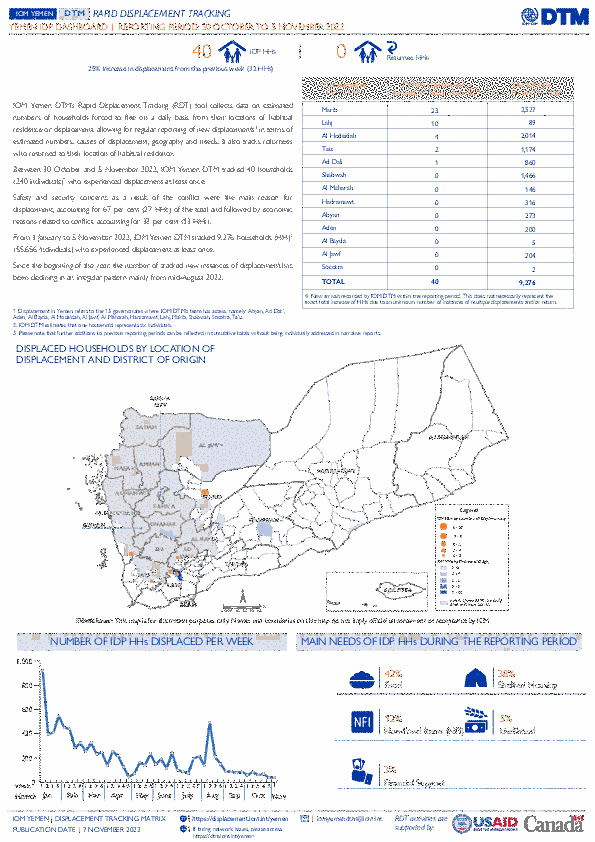
Contact
DTM Yemen, iomyemendtm@iom.int
Language
English
Location
Yemen
Period Covered
Oct 30 2022
Nov 05 2022
Activity
- Rapid Emergency Registration
- Mobility Tracking
IOM Yemen DTM’s Rapid Displacement Tracking (RDT) tool collects data on estimated numbers of households forced to flee on a daily basis from their locations of origin or displacement, allowing for regular reporting of new displacements in terms of estimated numbers, geography, and needs. It also tracks returnees who returned to their location of origin.
From 1 January to 5 November 2022, IOM Yemen DTM tracked 9,276 households (HH) (55,656 Individuals) who experienced displacement at least once.
Between 30 October and 5 November 2022, IOM Yemen DTM tracked 40 households (240 individuals) displaced at least once. The majority of people moved into/within the following governorates and districts:
- Marib (23 HHs) – Marib City (16 HHs), Marib (7 HHs) districts. Most displacements in the governorate originated from Shabwah and Marib.
- Lahj (10 HHs) – Al Musaymir (10 HHs) district. All displacements in the governorate were internal.
- Al Hodeidah (4 HHs) – Hays (4 HHs) district. Most displacements in the governorate originated from Al Hodeidah and Taiz.
The majority of people moved from the following governorates and districts:
- Lahj (11 HHs) – Al Musaymir (11 HHs) district.
- Al Hodeidah (5 HHs) – Hays (3 HHs), Al Marawiah (2 HHs) districts.
Shabwah (4 HHs) – Ataq (3 HHs), Bayhan (1 HH) districts.
Contact
DTM Yemen, iomyemendtm@iom.int
Location
Yemen
Activity
- Mobility Tracking
- Event Tracking
Period Covered
Oct 30 2022 -Nov 05 2022
From 1 January to 5 November 2022, IOM Yemen DTM tracked 9,276 households (HH) (55,656 Individuals) who experienced displacement at least once.
Between 30 October and 5 November 2022, IOM Yemen DTM tracked 40 households (240 individuals) displaced at least once. The majority of people moved into/within the following governorates and districts:
- Marib (23 HHs) – Marib City (16 HHs), Marib (7 HHs) districts. Most displacements in the governorate originated from Shabwah and Marib.
- Lahj (10 HHs) – Al Musaymir (10 HHs) district. All displacements in the governorate were internal.
- Al Hodeidah (4 HHs) – Hays (4 HHs) district. Most displacements in the governorate originated from Al Hodeidah and Taiz.
- Lahj (11 HHs) – Al Musaymir (11 HHs) district.
- Al Hodeidah (5 HHs) – Hays (3 HHs), Al Marawiah (2 HHs) districts.
- Shabwah (4 HHs) – Ataq (3 HHs), Bayhan (1 HH) districts.
Population Groups
Survey Methodology
Unit of Analysis Or Observation
Type of Survey or Assessment
Keywords
Geographical Scope
Administrative boundaries with available data
The current dataset covers the following administrative boundaries
Nouvelles arrivées dans la Zone Métropolitaine de Port-au-Prince (15 – 21 Octobre 2022)
Nouveaux déplacements dans la Zone Métropolitaine de Port-au-Prince (15 – 21 Octobre 2022)
Nouvelles arrivées dans la Zone Métropolitaine de Port-au-Prince (8 – 14 Octobre 2022)
Nouveaux déplacements dans la Zone Métropolitaine de Port-au-Prince (8 – 14 Octobre 2022)
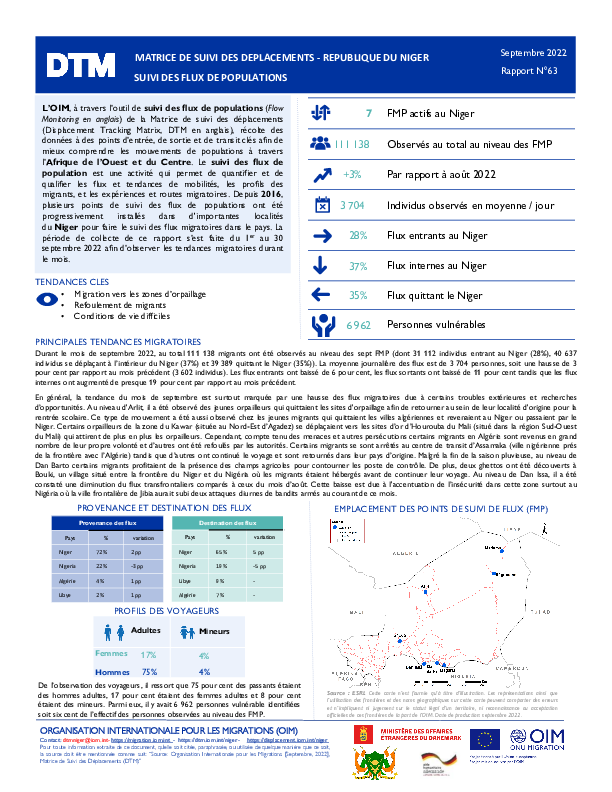
Contact
DTM Niger, DTMNiger@iom.int
Language
French
Location
Niger
Period Covered
Sep 01 2022
Sep 30 2022
Activity
- Flow Monitoring
L’OIM, à travers l’outil de suivi des flux de populations (Flow Monitoring en anglais) de la Matrice de suivi des déplacements (Displacement Tracking Matrix, DTM en anglais), récolte des données à des points d’entrée, de sortie et de transit clés afin de mieux comprendre les mouvements de populations à travers l’Afrique de l’Ouest et du Centre. Le suivi des flux de population est une activité qui permet de quantifier et de qualifier les flux et tendances de mobilités, les profils des migrants, et les expériences et routes migratoires. Depuis 2016, plusieurs points de suivi des flux de populations ont été progressivement installés dans d'importantes localités du Niger pour faire le suivi des flux migratoires dans le pays. La période de collecte de ce rapport s’est faite du 1er au 30 septembre 2022 afin d’observer les tendances migratoires durant le mois.
